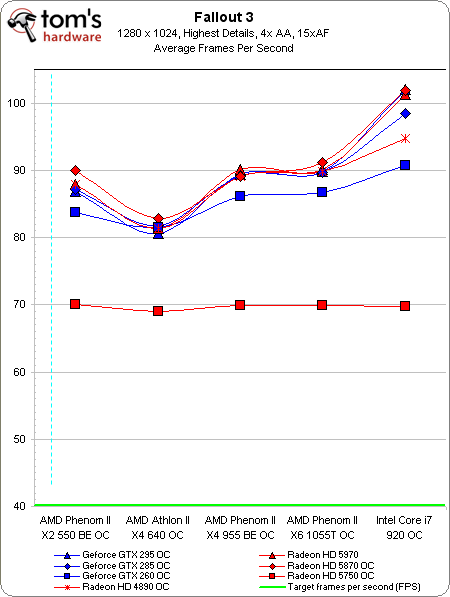Part 4: Building A Balanced Gaming PC
What does it mean to build a truly-balanced PC? How great would it be to piece together a machine bottlenecked by neither CPU or GPU? We set forth to measure the perfect balance in seven different games and four resolutions in this fourth of many parts.
Benchmark Results: Fallout 3
Fallout 3
In Fallout 3, we use FRAPS to benchmark a 60 second run through our “Capital Wasteland” saved game. For smoother combat sequences, we’ll again keep the target at 40 FPS in this action RPG. There was no problem cranking details to maximum, while also enabling 4x AA and 15x AF to further enhance the gaming experience.
There’s a clear GPU limitation at a very playable 70 FPS for the Radeon HD 5750, but all the other graphics cards look fairly CPU-limited. The lack of L3 cache appears to hurt the Athlon II X4 640 more than the small clock rate disadvantage. Even still, it is still capable of delivering over 80 FPS.
A little more GPU bottlenecking is evident at 1680x1050. Once again, the Core i7 leads the way, while the Athlon II lags behind the three Phenom II processors. Averaging nearly 60 FPS, the cheapest configuration is still easily playable.
The Radeon HD 5870 is competitive with the dual-GPU cards when it's matched up to any of the overclocked AMD CPUs, but is now left slightly behind on the Core i7 platform. Once again, the Phenom II X2 550 BE and Radeon HD 5750 still deliver solid performance.
All of the single-GPU cards are limiting performance, while the dual-GPU cards still shine a light on the least and most capable processors in Fallout 3. At 2560x1600, we have exceeded the capabilities of the Radeon HD 5750. But the GeForce GTX 260 and Radeon HD 4890 both remain well above our performance target.
Get Tom's Hardware's best news and in-depth reviews, straight to your inbox.
Current page: Benchmark Results: Fallout 3
Prev Page Benchmark Results: Grand Theft Auto IV Next Page Benchmark Results: Need For Speed Shift-
wildeast "such as NVidia’s GeForce GTX 400-series and revamp the benchmark suite with some new DirectX 11 titles."Reply
i'll be waiting for that, and maybe some i5 cpu to see what fit sli best -
jsowoc "We set forth to measure the perfect balance in seven different games and four resolutions in this third of many parts." (?)Reply
I think you copied this paragraph from part 3 and forgot to change it to 4... ;-) -
theshonen8899 With the amount of love you guys have for the Athlon x3 I was really hoping to see it on here :\Reply
I guess I can kind of predict where it'd fall though. -
L0tus Brilliant piece.Reply
I wish I had read this before building my system as I can see that I clearly spent too much on my CPU instead of GPU (i5-750 + HD5770) . Would have done much better with (X2 550 BE + HD5850) !
...ain't hind sight a b***h!
Also interesting to see how GPUs really start to distinguish themselves at higher resolutions. Again, brilliant work. -
TheStealthyOne I built a computer for my brother using a Phenom ii 550 paired with a 5770, and it screams! Fantastic gaming chip! It just goes to show you can achieve fantastic performance by planning and balance.Reply -
garlik_bread Personally, i'd be interested to see results from a card with less han 1GB RAM on the GPU.Reply
On the lower end of the spectrum, with the lower resolutions, is the 1GB really necessary?
Basically, i have a 512MB Asus 5770 and want to validate my purchase :D -
plasmastorm Still running a Maximus formula 775 board with a Q6600, 8gb ram and a Radeon 5850 but this is certainly handy for future reference.Reply
Probably skipping the i5/i7 generation as I can still play anything at max settings on my 22" monitor while running a 2nd for a film tho :) -
descendency plasmastormStill running a Maximus formula 775 board with a Q6600, 8gb ram and a Radeon 5850 but this is certainly handy for future reference.Probably skipping the i5/i7 generation as I can still play anything at max settings on my 22" monitor while running a 2nd for a film thoReply
i5/i7 isn't a generation. it's like 5 or so.
It's the same thing as C2D and C2Q



